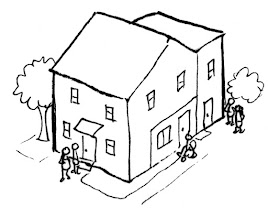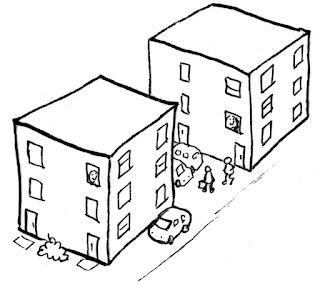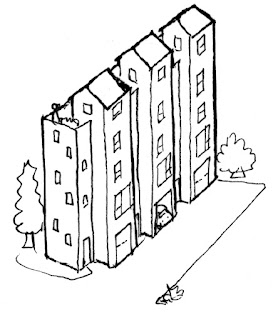California Triplex (House + ADU + Junior ADU)
Time period: 2020s and onwards
Location: California
California state law allows a single-family home to become three homes:
1. The main house, which can be whatever size allowed by zoning
2. An attached or detached Accessory Dwelling Unit (ADU). Can be any size, cities must allow at least 800 square feet (enough for a 2-bedroom, 3 if you squeeze it)
3. An attached Junior Accessory Dwelling Unit (JADU), of up to 500 square feet.
Example of a house with a Junior ADU and a regular ADU on a 5,000 square foot, 50'x100' lot. Total of 3,800 square feet of living space with 3 homes with a total of 7 bedrooms (4 in house, 2 in ADU, 1 in Junior ADU).
While California state law as of 2022 also allows up to 4 homes (double duplex)
using Senate Bill 9, the ADU+JADU route is currently more popular, for
two reasons: First, fees and code requirements are lower for ADUs.
Second, many cities have put up barriers to using SB9 - this is in the
process of being corrected by cleanup legislation.
It was a long road getting there. While today's ADUs can be bought prefab and installed by crane from the back of a truck, the legislation that made it possible was a four-decade process of over a dozen state laws, each building on the foundation of the previous ones.
Why ADU?
As late as the 1970s, housing costs in California were only slightly higher than the rest of the country. That changed when cities, especially those on the coast, passed local laws that made it difficult to build new homes. Over the next three decades, coastal cities built less than 1/3 of the homes that were needed to keep up with job growth.
With more people complaining about high housing costs, state legislators started to see that this was a problem that needed solving. Accessory dwelling units (ADUs), then known as secondary dwelling units, offered a politically friendly solution. Instead of very noticeable apartment complexes, ADUs could provide low cost studio and one-bedroom homes hidden inside or behind existing houses.
First Steps in the 1980s
Democratic State Senator Henry Mello (best known for the Mello-Roos act that allowed the forming of special tax districts for funding infrastructure and community facilities) wrote the first ADU bill, Senate Bill 1534. Mello represented Santa Cruz County, which had, and still has, one of California's worst housing shortages. At first glance, SB1534 allowed ADUs statewide. In practice, it had a couple of big loopholes:
- Cities could pass zoning standards that made it impossible to build ADUs, such as requiring a minimum lot size larger than the average lot.
- Cities could also ban ADUs entirely, by making an argument that it would affect health, safety, or the general welfare of the city.
While ineffective, SB1534 laid the foundation for future, more transformative ADU legislation.
ADUs are typically built on existing lots with existing homes. Above is an example of how cities can intentionally ban ADUs by requiring yard, lot size, and parking requirements that existing lots cannot meet.
A Second Attempt in the early 2000s
The 1990s recession caused a temporary drop in California housing costs. By the late 1990s, with the dotcom boom, housing costs reached new heights, and the housing crisis landed on legislators' radar again.
The next major attempt to increase ADU production was 2002's Assembly Bill 1866. Introduced by Rod Wright, a Democrat from southern Los Angeles County, AB1866 required local government to approve ADUs through staff level review instead of public hearings. Also known as ministerial review or permit streamlining, this greatly reduces the cost and time of getting a project approved.
AB 1866 also strengthened California's density bonus law, which allows apartment buildings to have more units if a percentage of them are set aside as low income housing. It was supported by a big coalition that included Realtors, landlords, tenant organizers, labor unions, and affordable housing nonprofits. It was opposed by some cities and the American Planning Association. The final vote was close - just 45 of 80 Assemblymembers voted yes. At the time, Democrats held 50 seats in the Assembly.
Again, cities responded to AB1866 by passing additional standards that made it impossible to build ADU, or outright ignoring the requirement to have ADUs go through staff review instead of public hearings. As a result, the bill also had limited effect.
Rapid Progress in the 2010s
Another recession in 2008 put another pause in housing cost increases and legislation. Like the earlier one, it was only temporary relief - by the mid 2010s, housing costs were again a top issue for California. This time, there was the political will to pass much stronger legislation.
In 2016, a pair of bills were introduced by Bob Wieckowski, a Democrat from Fremont in the Bay Area, and Richard Bloom, a Democrat from Santa Monica. Both represented districts with lots of suburban single-family zoning and extremely high housing costs. SB 1069 (Wieckowski) and AB 2299 (Bloom) included the following:
- Required local government to allow one ADU on single family lots. Opting out was no longer allowed, and additionally, excessive yard and density rules were also banned.
- Required local government to review ADU permit applications in 90 days.
- Eliminated utility connection fees or requirements for ADUs located in existing structure.
- Eliminated parking requirements for ADUs built near transit or carshare, in a historic district, in an existing structure, or in a Residential Parking Permit zone where ADU residents don't get parking permits.
A similarly broad coalition backed SB1069. This time, the American Planning Association switched over to the support side. SB1069 got 55 out of 80 votes in the Assembly, and 30 out of 40 State Senators. This bill was more partisan - most Democrats supported and most Republicans opposed. At this time, Democrats held 52 seats in the Assembly.
SB1069 was the bill that kicked off California's current ADU building boom. In just three years, the number of ADUs being approved in California went from around 1,000 per year to over 10,000 and rising. Los Angeles County, with its larger backyards, saw an even more dramatic increase, with ADU permits jumping from a few dozen per year to a few thousand per year. This created an entire new ADU industry, which would mobilize to help pass additional ADU laws in following years.
Comparison of LA lot vs. Bay Area lot. A typical LA lot is almost twice the size, and has more backyard, which meant that homeowners could build an ADU and still have lots of backyard space. This was especially true before 2022, when state law was changed to require cities to allow 2-story ADUs.Follow-Up: Fewer hurdles, more homes
The following years saw a number of cleanup bills from Wieckowski, Bloom, and other legislators that knocked off remaining hurdles that cities had put on ADUs, including:
- Minimum lot size requirements
- Owner occupancy requirements
- Parking requirements, including replacement parking for garage conversions
- Permit Fees
- Homeowner Association rules that banned rentals
- Shortened the time period for approvals
- Height limits
- As a backstop, state law also included a line that allowed any remaining local zoning restrictions to be overridden if an 800-square-foot ADU could not otherwise be built.
Like SB1069, votes on these bills was partisan - most
Democrats supported and most Republicans opposed. By now, Democrats held a overwhelming supermajority of around 3/4 of seats in both the Senate and Assembly. Other legislators that wrote major ADU bills included Assemblymember Phil Ting, who represented the western, lower density side of San Francisco, Sharon Quirk-Silva from Orange County, and Rudy Salas from the Central Valley. All were Democrats.
Junior ADUs
California also created a new category, the Junior ADU, which is a small unit (up to 500 square feet) built entirely or mostly from space within the existing house.
While a regular ADU requires its own kitchen and bathroom, a Junior ADU only requires a kitchen - the bathroom can be shared with the main house. This rule was written with multigenerational living in mind.
Multifamily ADUs
In addition to making ADUs easier to build on single family lots, 2019's Assembly Bill 68 (Ting) also created allowed ADUs to be added to apartment buildings. Apartment owners are more likely than the average homeowner to have the money to build ADUs, as well as the interest in being a landlord. AB68 allowed garages, storage rooms, and other spaces to be converted into ADUs. Each apartment building could add up to 25% more units. Triplexes and duplexes could convert space into one ADU.
On top of that, two standalone detached ADUs to be built. These could be built even if the existing building exceeded current zoning limits.
Together, this effective upzoned every multifamily lot by 25%, with much larger percentage increases for smaller buildings. A lot with a duplex could go from 2 homes to 5 homes, a 150% increase. Some developers started submitting plans for new buildings with extra storage and parking areas that were designed with future ADU conversion in mind.
Example of how an 8-unit apartment building can convert parking to ADUs and build additional standalone detached. This is legal even if the existing apartment building is a non-conforming structure in a single family zone.
Cities Embrace ADUs
By now, some cities were embracing ADUs instead of fighting them. For example, San Jose and Los Angeles now have pre-approved plans for detached ADUs. This speeds up the approval process even further - in some cases, both planning approval and building permit can be received the same day, like ordering a meal from a menu.
How ADUs are Financed
A small conversion ADU can still cost $100,000 in California, a large detached ADU can cost over a half million to build. This is far more cash than the average homeowner has on hand. Fortunately, financing and assistance is available:
- To help kick off ADU building, California offered $40,000 grants to cover design, permitting, and other pre-development costs.
- Homeowners who have fully paid off their home, or have paid off a significant part of their mortgage, can refinance to borrow money against the value of their home. They then pay it back like a regular mortgage.
- Homeowners with limited equity can get a short-term ADU loan from a bank or credit union to cover the cost of construction. Once the ADU is built, their property is now worth more, and they can refinance to get a larger mortgage. This has gotten easier in recent years as ADUs have become more common and the laws around them expanded.
Previously, appraisers had valued ADUs very conservatively, far less than a similar-sized addition to a house would be valued at, because of a lack of comparable sales data (comps). Today in California, since the passage of SB9 (which allows up a property to have up to 2 homes, or 4 if the lot is split) properties that contain an ADU can use duplexes as comps, allowing for a more accurate appraised value.
Future Legislation
As of 2023, pending legislation includes bills that would:
- Set up pre-approved ADU programs in all cities
- Allow ADUs to be sold separately from the main building, as a condo
- Provide more funding for nonprofits to build ADUs
Data (House + ADU + Junior ADU)
- Density: 10-30+ units/acre
- Typical Lot Size: 4,000 to 10,000 square feet
- Typical Zoning: Single Family Residential, Low Density Residential
- Construction Type: Wood Frame
- Resident Type: Rental
Where to build
- Single family zones in California
- Apartment building storage space, parking lots and yards (AB68 multifamily ADUs)
Further Reading
California ADU FAQ https://www.hcd.ca.gov/sites/default/files/2022-07/ADUHandbookUpdate.pdf
California's High Housing Costs, Causes and Consequences https://lao.ca.gov/reports/2015/finance/housing-costs/housing-costs.aspx
How cities blocked ADUs https://scholarworks.calstate.edu/downloads/b8515q74j
The result of 40 years of opposing housing in Santa Cruz https://darrellowens.substack.com/p/santa-cruz-is-a-housing-nightmare
A brief history of ADU laws in California https://twitter.com/cayimby/status/1660794873480638464History of ADU Legislation https://calhdf.org/wp-content/uploads/2021/05/A-Guide-to-Ending-Single-Family-Zoning-CaRLA-May-2021.pdf
History of ADUs in San Francisco https://www.spur.org/publications/spur-report/2006-06-01/secondary-units
History of ADUs in Los Angeles https://www.sightline.org/2019/04/05/la-adu-story-how-a-state-law-sent-granny-flats-off-the-charts/
AB1866 (2002) https://leginfo.legislature.ca.gov/faces/billTextClient.xhtml?bill_id=200120020AB1866
SB1069 (2016) https://leginfo.legislature.ca.gov/faces/billTextClient.xhtml?bill_id=201520160SB1069
AB68 (2019) https://leginfo.legislature.ca.gov/faces/billNavClient.xhtml?bill_id=201920200AB68
Changes in ADU production in California and LA after SB1069 https://www.buildinganadu.com/adu-blog/california-adu-charts
2019 ADU legislation https://calhdf.org/2019/09/13/making-sense-of-this-years-adu-legislation/
ADU permitting and production trends https://www.cotta.ge/resources/california-adu-report
Junior ADU info https://www.hcd.ca.gov/policy-research/docs/faqsadujr.pdf
Multifamily ADU info https://designeverest.com/research-library/can-i-build-multiple-adus/
Examples of multifamily ADUs https://openscopestudio.com/multifamily-adus-in-california-new-rules-are-available-to-ease-the-path-for-apartment-owners-statewide/
How new apartment buildings are designed to be ready for adding more ADUs https://www.fidentcapital.com/multifamily-adus-in-new-construction-californias-biggest-density-bonus-of-all%EF%BF%BC/
San Jose pre-approved ADU plans https://www.sanjoseca.gov/business/development-services-permit-center/accessory-dwelling-units-adus/preapproved-adus
Los Angeles pre-approved ADUs https://ladbs.org/adu/standard-plan-program/approved-standard-plans
Ways ADUs are financed https://homeplex.net/blog/how-to-finance-an-adu/
Challenges with appraising ADUs in early 2021 https://www.jvmlending.com/blog/valuing-an-in-law-unit-or-an-adu-accessory-dwelling-unit/
Discussion on appraisals of houses with ADUs https://www.biggerpockets.com/forums/52/topics/844341-adu-appraisal-california?page=2
State grant to cover ADU design and other pre-development costs https://www.calhfa.ca.gov/adu/
Nonprofit that assists homeowners with designing and financing ADUs https://www.helloadu.org/individual-services
2023 California legislation https://alfredtwu.medium.com/2023-california-housing-legislation-highlights-bill-tracker-843ba2e9f820









Comments
Post a Comment